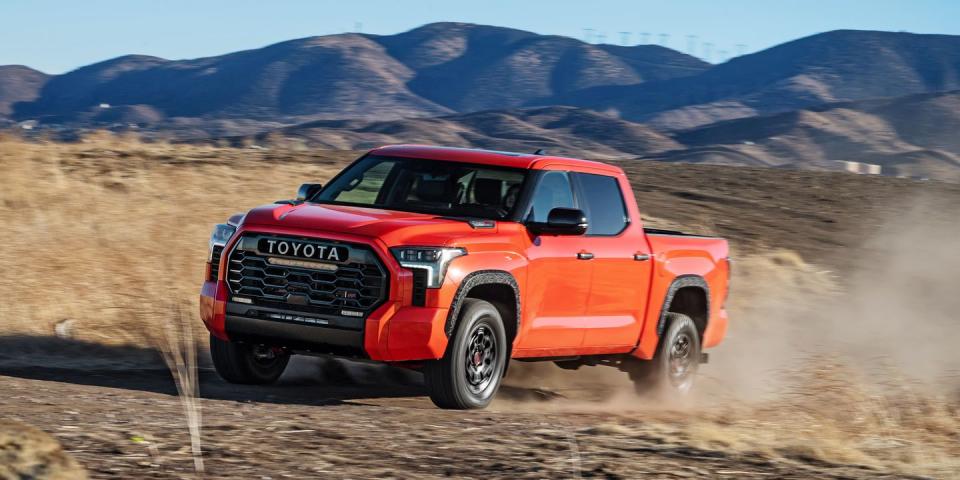Tested: 2022 Toyota Tundra Pickup Goes Big

UPDATE 1/6/22: This review has been updated with test results.
The Toyota Tundra is old. How old? It's so old, when it was introduced, the Dead Sea was just getting sick. It's so old, if you park one outside an antiques store, people will try to buy it. It's so old, it was introduced in 2007. Which is, uh, 14 years ago. The fact that Toyota still sells more than 100,000 Tundras a year is a testament to the effort it expended on that mid-2000s redesign—a 381-hp V-8 was killer then and still relevant now. But it's (long past) time for an update, and so the 2022 Tundra gets a thorough overhaul that sets Toyota up for another long production run. Maybe not 14 years this time, though.
Gone is the V-8, leaving the ancient Sequoia as the only remaining V-8-powered Toyota in the U.S. All Tundras are now powered by a twin-turbo 3.4-liter V-6 paired with a 10-speed automatic transmission. (Toyota, though, incorrectly refers to it as a 3.5-liter.) Hybrid models, dubbed "i-Force MAX," sandwich a 48-hp electric motor between the engine and transmission, with a small nickel-metal hydride battery mounted beneath the rear seat. The standard configuration makes 389 horsepower and 479 pound-feet of torque. The muscled-up hybrid churns out 437 horsepower and 583 pound-feet of torque. Only the entry-level SR trim makes less power than the outgoing truck, with its V-6 tuned for 348 horsepower and 405 pound-feet.

The other major hardware change concerns the rear suspension, which is now a coil-spring design. Optional air springs enable automatic load leveling but can also be manually controlled, to either lower the rear end to ease loading or raise it for off-roading. Which, given the fixed front ride height, means that the Tundra can Carolina Squat itself.
Trim levels mirror the previous-gen truck, starting with the basic SR and the volume-model SR5 and climbing through fancier Limited, Platinum, and 1794 variants. The TRD Pro is now hybrid-only, but the hybrid-adverse can build an SR5 that nearly replicates the TRD Pro's hardware. The new TRD Off-Road package includes TRD wheels and suspension (though not the Pro's Fox internal-bypass front dampers and remote-reservoir rears), along with a locking rear differential—the first time an electronic locker has been offered on a Tundra. If you want to go in the opposite direction, there's also a TRD Sport package that lowers the ride height.

Maximum payload is now 1940 pounds, and that almost-ton of stuff rides in a rugged new aluminum-reinforced composite bed—the "make the whole plane out of the black box" approach to bedliner. Nonetheless, Toyota still offers both a bed mat and a spray-in bedliner as accessories. Why? Because a certain group of people demand so. We won't say who, but they'd be the ones who make a bunch of money selling you a bedliner for your bed. (They'll also install a three-inch lift kit, among a portfolio of other accessories.) Those beds are available in 5.5-foot, 6.5-foot, and 8.0-foot lengths, and Tundra buyers can now pair the crew cab with a 6.5-foot bed.
From the outside, the Tundra's redesign is conservative—huge grille notwithstanding—with a definite Silverado resemblance in the cab, particularly the upward kick of the sheetmetal at the bottom of the rear side windows. But inside, it's a huge departure from its predecessor. An 8.0-inch center touchscreen is standard, but every truck at the launch event had the optional 14.0-inch infotainment screen. The navigation system is the most obvious upgrade, running a cloud-based system that will automatically store maps offline if you're heading into an area with spotty connectivity. There's also a "Hey, Toyota" virtual assistant that can understand natural questions and commands. One thing that's missing from both systems is a tuner knob for the stereo. If you frequently listen to SiriusXM or terrestrial radio, that could be a major aggravation—the hard buttons on the steering wheel scroll through presets, but not from channel to channel. Up above the rearview mirror is the switch to roll down the rear glass, which is nice for talking to hitchhikers riding in the bed.


 Yahoo Autos
Yahoo Autos 